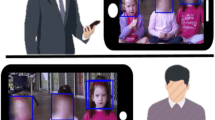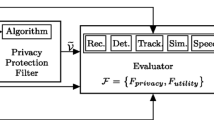Abstract
Huge amounts of video are being recorded every day by surveillance systems. Since video is capable of recording and preserving an enormous amount of information which can be used in many applications, it is worth examining the degree of privacy loss that might occur due to public access to the recorded video. A fundamental requirement of privacy solutions is an understanding and analysis of the inference channels than can lead to a breach of privacy. Though inference channels and privacy risks are well studied in traditional data sharing applications (e.g., hospitals sharing patient records for data analysis), privacy assessments of video data have been limited to the direct identifiers such as people’s faces in the video. Other important inference channels such as location (Where), time (When), and activities (What) are generally overlooked. In this paper we propose a privacy loss model that highlights and incorporates identity leakage through multiple inference channels that exist in a video due to what, when, and where information. We model the identity leakage and the sensitive information separately and combine them to calculate the privacy loss. The proposed identity leakage model is able to consolidate the identity leakage through multiple events and multiple cameras. The experimental results are provided to demonstrate the proposed privacy analysis framework.








Similar content being viewed by others
References
Aggarwal J, Cai Q (1997) Human motion analysis: a review. In: Proc. of IEEE nonrigid and articulated motion workshop, pp 90–102
Akyildiz I, Su W, Sankarasubramaniam Y, Cayirci E (2002) A survey on sensor networks. IEEE Commun Mag 40(8):102–114
Atrey P, Kankanhalli M, Jain R (2006) Information assimilation framework for event detection in multimedia surveillance systems. Multimedia Syst 12(3):239–253
Boyle M, Edwards C, Greenberg S (2000) The effects of filtered video on awareness and privacy. In: The ACM conference on computer supported cooperative work, pp 1–10
Carrillo P, Kalva H, Magliveras S (2008) Compression independent object encryption for ensuring privacy in video surveillance. In: IEEE international conference on multimedia and expo, pp 273–276
Chinomi K, Nitta N, Ito Y, Babaguchi N (2008) Prisurv: privacy protected video surveillance system using adaptive visual abstraction. In: Proceedings of the international conference on advances in multimedia modeling, pp 144–154
Chong C, Kumar S (2003) Sensor networks: evolution, opportunities, and challenges. Proc IEEE 91(8):1247–1256
Doulamis A, van Gool L, Nixon M, Varvarigou T, Doulamis N (2008) First ACM international workshop on analysis and retrieval of events, actions and workflows in video streams. In: ACM international conference on multimedia, pp 1147–1148
Dwork C (2006) Differential privacy. In: International colloquium on automata, languages and programming, pp 1–12
Fernández C, Baiget P, Roca FX, Gonzílez J (2011) Determining the best suited semantic events for cognitive surveillance. Expert Syst Appl 38(4):4068–4079
Ferrucci D (2010) Build watson: an overview of deepqa for the jeopardy! challenge. In: International conference on parallel architectures and compilation techniques, pp 1–2
Fidaleo D, Nguyen H, Trivedi M (2004) The networked sensor tapestry (nest): a privacy enhanced software architecture for interactive analysis of data in video-sensor networks. In: ACM iternational workshop on video surveill ance & sensor networks, pp 46–53
Fung B, Wang K, Chen R, Yu P (2010) Privacy-preserving data publishing: a survey on recent developments. In: ACM computing surveys, vol 42
Hayes-Roth F, Waterman D, Lenat D (1984) Building expert systems. Addison-Wesley, Reading, MA
Koshimizu T, Toriyama T, Babaguchi N (2006) Factors on the sense of privacy in video surveillance. In: ACM workshop on continuous archival and retrival of personal experences, pp 35–44
Langheinrich M (2001) Privacy by design - principles of privacy-aware ubiquitous systems. In: International conference on ubiquitous computing. Springer, pp 273–291
Lu Y, Ga W, Wu F (2002) Automatic video segmentation using a novel background model. In: The IEEE international symposium on circuits and systems, pp 807–810
McBratney A, Whelan B, Ancev T, Bouma J (2005) Future directions of precision agriculture. Precis Agric 6(1):7–23
Moncrieff S, Venkatesh S, West G (2008) Dynamic privacy assessment in a smart house environment using multimodal sensing. ACM Trans Multimed Comput Commun Appl 5(2): 1–29
Paruchuri JK, Cheung S, Hail MW (2009) Video data hiding for managing privacy information in surveillance systems. In: SPIE newsroom
Piciarelli C, Foresti G (2011) Surveillance-oriented event detection in video streams. In: IEEE intelligent systems, pp 32–41
Poppe R (2010) A survey on vision-based human action recognition. Image Vis Comput 28(6):976–990
Qureshi FZ (2009) Object-video streams for preserving privacy in video surveillance. In: International conference on advanced video and signal based surveillance, pp 442–447
Saini M, Atrey P, Mehrotra S, Emmanuel S, Kankanhalli M (2010) Privacy modeling in video data publication. In: IEEE international conference on multimedia and expo, pp 60–65
Senior A, Pankanti S, Hampapur A, Brown L, Tian YL, Ekin A, Connell J, Shu CF, Lu M (2005) Enabling video rivacy through computer vision. IEEE Secur Priv 3(3):50–57
Septian H, Tao J, Tan YP (2006) People counting by video segmentation and tracking. In: International conference on control, automation, robotics and vision, pp 1–4
Spindler T, Wartmann C, Hovestadt L, Roth D, Van Gool L, Steffen A (2006) Privacy in video surveilled areas. In: The ACM international conference on privacy, security and trust, pp 1–10
Sweeney L (2002) k-anonymity: a model for protecting privacy. Int J Uncertain Fuzziness Knowl-Based Syst 10(5):557–570
Thuraisingham B, Lavee G, Bertino E, Fan J, Khan L (2006) Access control, confidentiality and privacy for video surveillance databases. In: ACM symposium on access control models and technologies, pp 1–10
Turaga P, Chellappa R, Subrahmanian V, Udrea O (2008) Machine recognition of human activities: a survey. IEEE Trans Circuits Syst Video Technol 18(11):1473–1488
Van Harmelen F, Lifschitz V, Porter B (2008) Handbook of knowledge representation. Elsevier Science Ltd
Westermann U, Jain R (2007) Toward a common event model for multimedia applications. IEEE Multimed 14(1):19–29
Wickramasuriya J, Datt M, Mehrotra S, Venkatasubramanian N (2004) Privacy protecting data collection in media spaces. In: International conference on multimedia, pp 48–55
Wiles R, Hirvonen D, Hsu S, Kumar R, Lehman W, Matei B, Zhao W (2001) Video georegistration: algorithm and quantitative evaluation. In: Proc. of IEEE international conference on computer vision, vol 2, pp 343–350
Zhu Z, Oskiper T, Samarasekera S, Kumar R, Sawhney H (2007) Ten-fold improvement in visual odometry using landmark matching. In: Proc. IEEE international conference on computer vision, pp 1–8
Zhu Z, Oskiper T, Samarasekera S, Kumar R, Sawhney H (2008) Real-time global localization with a pre-built visual landmark database. In: Proc. of IEEE conference on computer vision and pattern recognition, pp 1–8
Author information
Authors and Affiliations
Corresponding author
Rights and permissions
About this article
Cite this article
Saini, M., Atrey, P.K., Mehrotra, S. et al. W3-privacy: understanding what, when, and where inference channels in multi-camera surveillance video. Multimed Tools Appl 68, 135–158 (2014). https://doi.org/10.1007/s11042-012-1207-9
Published:
Issue Date:
DOI: https://doi.org/10.1007/s11042-012-1207-9




